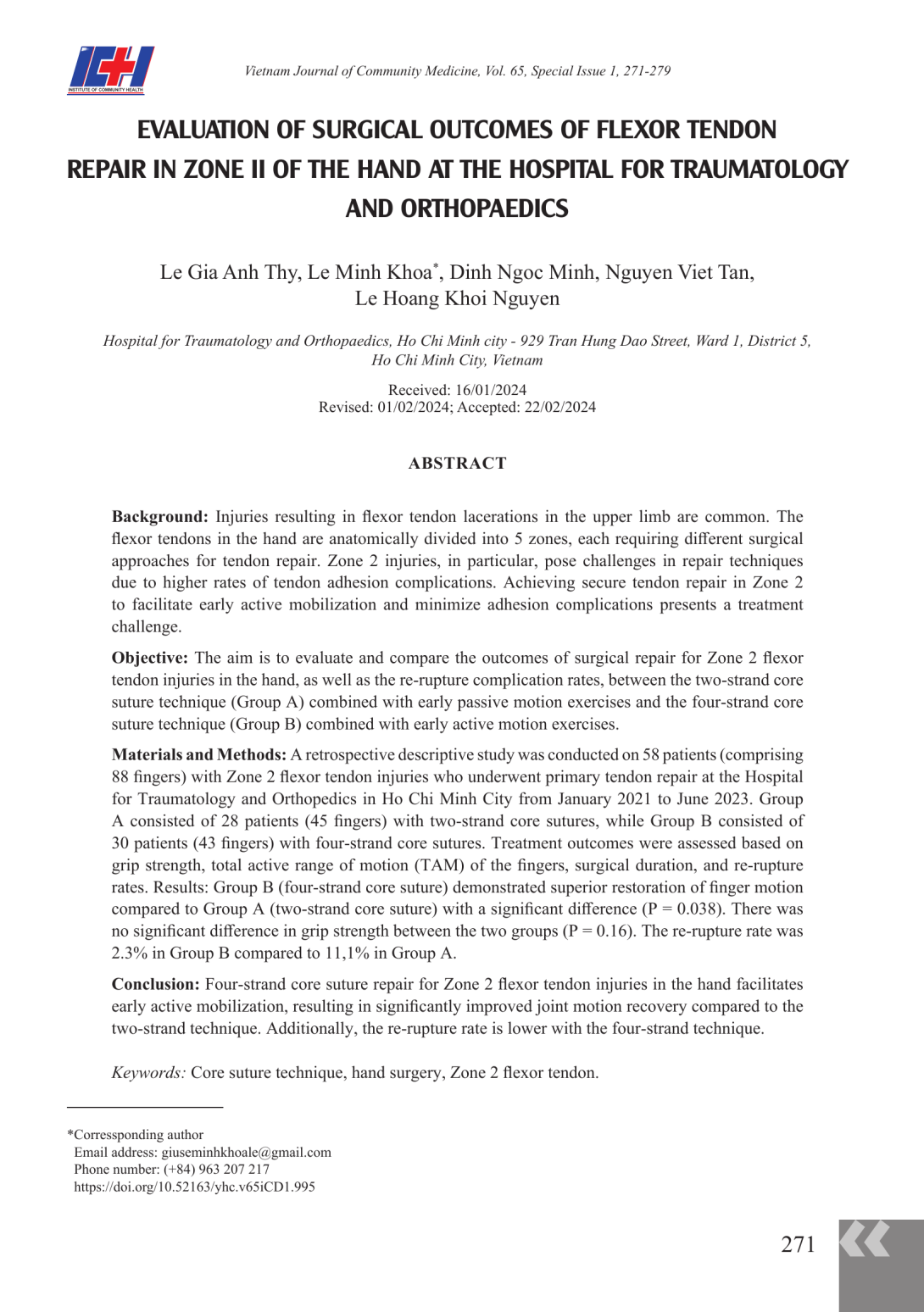
Vết thương do vật sắc nhọn cắt gây đứt gân gấp ở chi trên rất thường gặp. Gân gấp các ngón tay được chia làm 5 vùng theo giải phẫu, mỗi vùng có thể có những cách phẫu thuật khâu nối gân khác nhau. Trong đó vùng 2 là vùng khó khâu nối và gặp biến chứng dính gân nhiều nhất. Khâu nối gân vùng 2 như thế nào để đủ vững chắc giúp tập được vận động chủ động sớm tránh biến chứng dính gân mà gân không bị đứt lại là một thách thức điều trị. Mục tiêu: Nhằm đánh giá và so sánh kết quả phẫu thuật khâu nối gân gấp vùng 2 ở bàn tay cũng như tỷ lệ biến chứng đứt lại giữa kỹ thuật khâu 2 sợi trục (nhóm A) tập vận động gấp thụ động sớm với 4 sợi trục (nhóm B) tập vận động gấp chủ động sớm. Đối tượng và phương pháp nghiên cứu: Nghiên cứu hồi cứu mô tả 58 bệnh nhân (88 ngón tay) bị vết thương đứt gân gấp vùng 2 bàn tay được khâu nối thì đầu tại Bệnh viện Chấn thương chỉnh hình TP. HCM từ 01/2021 – 06/2023, trong đó nhóm khâu 2 sợi trục (A) có 28 bệnh nhân với 45 ngón, nhóm khâu 4 sợi trục (B) có 30 bệnh nhân với 43 ngón. Đánh giá kết quả điều trị dựa vào đo lực nắm, tổng biên độ vận động chủ động của ngón tay (TAM), thời gian phẫu thuật, tỷ lệ gân bị đứt lại. Kết quả: Nhóm B khâu 4 sợi trục phục hồi biên độ vận động của ngón tốt hơn nhóm A khâu 2 sợi trục với P = 0,038. Không có sự khác biệt về lực nắm giữa 2 nhóm, với P = 0,16. Tỷ lệ đứt lại nhóm B là 2,3 %, nhóm A là 11,1%. Kết luận: Khâu gân gấp vùng 2 bàn tay với 4 sợi trục tạo điều kiện tập vận động gấp chủ động sớm, giúp hồi phục tầm vận động khớp tốt hơn hẳn khâu 2 sợi trục, và tỷ lệ đứt lại thấp hơn.
Injuries resulting in flexor tendon lacerations in the upper limb are common. The flexor tendons in the hand are anatomically divided into 5 zones, each requiring different surgical approaches for tendon repair. Zone 2 injuries, in particular, pose challenges in repair techniques due to higher rates of tendon adhesion complications. Achieving secure tendon repair in Zone 2 to facilitate early active mobilization and minimize adhesion complications presents a treatment challenge. Objective: The aim is to evaluate and compare the outcomes of surgical repair for Zone 2 flexor tendon injuries in the hand, as well as the re-rupture complication rates, between the two-strand core suture technique (Group A) combined with early passive motion exercises and the four-strand core suture technique (Group B) combined with early active motion exercises. Materials and Methods: A retrospective descriptive study was conducted on 58 patients (comprising 88 fingers) with Zone 2 flexor tendon injuries who underwent primary tendon repair at the Hospital for Traumatology and Orthopedics in Ho Chi Minh City from January 2021 to June 2023. Group A consisted of 28 patients (45 fingers) with two-strand core sutures, while Group B consisted of 30 patients (43 fingers) with four-strand core sutures. Treatment outcomes were assessed based on grip strength, total active range of motion (TAM) of the fingers, surgical duration, and re-rupture rates. Results: Group B (four-strand core suture) demonstrated superior restoration of finger motion compared to Group A (two-strand core suture) with a significant difference (P = 0.038). There was no significant difference in grip strength between the two groups (P = 0.16). The re-rupture rate was 2.3% in Group B compared to 11,1% in Group A. Conclusion: Four-strand core suture repair for Zone 2 flexor tendon injuries in the hand facilitates early active mobilization, resulting in significantly improved joint motion recovery compared to the two-strand technique. Additionally, the re-rupture rate is lower with the four-strand technique.
- Đăng nhập để gửi ý kiến
